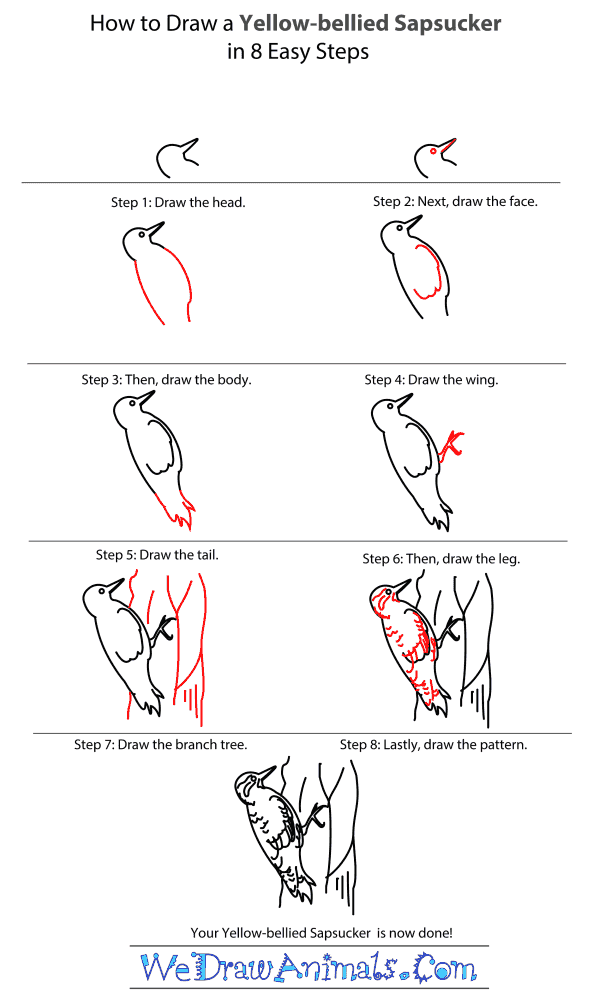In this quick tutorial you'll learn how to draw a Yellow Bellied Sapsucker in 8 easy steps - great for kids and novice artists.
The images above represent how your finished drawing is going to look and the steps involved.
Below are the individual steps - you can click on each one for a High Resolution printable PDF version.
At the bottom you can read some interesting facts about the Yellow Bellied Sapsucker.
Make sure you also check out any of the hundreds of drawing tutorials grouped by category.
How to Draw a Yellow Bellied Sapsucker - Step-by-Step Tutorial
Step 1: Start by drawing the head. The back of the head is a crooked "C" shape. At the top of the head is a long pointy beak. Continue the bottom of the beak line into the front of the neck.
Step 2: Draw a straight line along the beak to make the mouth. At the end of the beak draw a round eye.
Step 3: Keep drawing the neck line down and curve it to the right and then down again. Continue the back of the left head line down to make the back line.
Step 4: Just under the neck start drawing the wing line. It curves along the inside of the right body line and curves down and to the left. Make the end bumpy to make the wing feathers.
Step 5: Continue drawing the two body lines down to make the tail. The end of the tail has several points to make the tail feathers.
Step 6: Now draw the front leg. In the middle of the right body line draw two thin lines angled up into the foot. There are three pointy toes. Two point up and the other points down.
Step 7: Now draw a series of curvy lines going up and down. This is the tree branch that the sapsucker is perched on.
Step 8: Finally, draw a lot of squiggly and curved lines along the body to make the feather markings.
Interesting Facts about the YELLOW-BELLIED SAPSUCKER
The Yellow-Bellied Sapsucker is a member of the bird group and the scientific term for them is Sphyrapicus varius. Their name is derived from the golden color on the stomach. They also have a white body with black stripes, and a red head. This species is a woodpecker that has a medium size and is found in young forests of North America, Central America, and the Caribbean, which contain new trees with lots of fresh sap.
Did you know?
- This animal was first documented in 1766.
- The length is up to over 3/4 of a foot long.
- Their wingspan is almost 1.5 feet wide.
- They weigh more than 1/8 of a pound.
- This creature feeds on up to 250 species of trees.
Without the yellow coloring, only an expert on birds can distinguish this creature from certain types of other woodpeckers, such as the Red-Naped Sapsucker, the Hairy Woodpecker, and the Downy Woodpecker. This bird makes a sound like a cat and uses it to mark its territory. They are a parasite to trees and a major cause for the degradation of forests. These animals have a low population amount, but are considered to be the least concern for the possibility of extinction.









